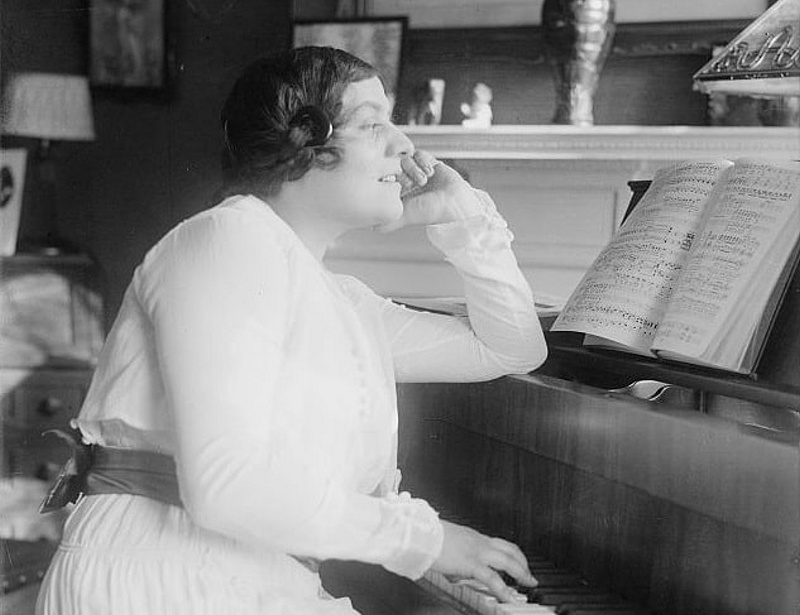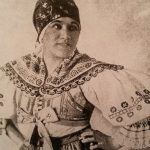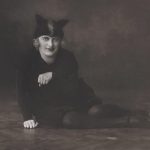During the first two decades of the 20th century, as recording technology gradually took off, Rusalka’s Song to the moon was by far the most common Czech opera recording, with arias from Hubička coming in second place. You can listen to the aesthetic nuances of the individual singers’ performances from this time on our YouTube channel, which includes recordings of artists still famous today and other less familiar names. The latter tend to be the most surprising. Today we bring you two rare recordings of the nearly-forgotten Czech soprano Heřma Žárská (1889-1971) who recorded them for the Columbia Records company after her engagement at the Metropolitan Opera in 1915 and 1916.
On the recording, made in 1916, Heřma Žárská sings Rusalka’s aria in a relaxed and liberal manner with a slightly Italianate agogic accent. Interestingly, there are several cuts made to the music. Right at the end of the first phrase, after the words „daleko vidí,“ (“sees far”), a measure is missing and, similarly, after “bloudíš širokém” (“roaming the wide world”) the two woodwind echos are missing. As was the custom at the time, the singer leaves out words in the higher tessitura and the interlude is omitted. In the next verse, there’s even a surprising omission of the second iteration of the statement „aby si alespoň chviličku…“ (“so that just for a moment…”) The orchestral measure before the final „měsíčku nezhasni“ (“moon, don’t go out”) is once again left out. We don’t know the reason for these modifications. It’s possible that the times called for such edits given the limited capacity of early vinyl records. Although, interestingly, the Victor Talking Machine Company recorded the same aria with Ema Destinnová (Emmy Destinn) a year earlier without cuts.
The string instruments of the orchestra and the soloist use a very heavy portamento, a common stylistic feature of the time. This technique might sound a bit bizarre to today’s listener but does show us what Rusalka probably sounded like during Dvořák’s lifetime.
The other side of the disk contains Vendula’s lullabies from Smetana’s Hubička. Žárská debuted in the role for the National Theatre two years prior, to high critical acclaim. Her recording for Columbia Records was, of course, neither the beginning nor end of Heřma Žárská’s career. You can read up more on the life of this fascinating singer in the following article by Milan Valden.
The Forgotten Soprano Heřma Žárská
The name Hermína (Heřma) Žárská (1889–1971) is among the least recognizable among those of Czech singers who appeared on the stage of the Metropolitan opera in New York. Žárská only performed six times for the MET, during the 1915-1916 seasons, in two roles, four opera performances, and two Sunday concerts. She also sang at the Prague National Theatre and the Slovak National Theatre in Bratislava.
Hermína Maria Žárská was born on the 9th of June in 1889 in Olomouc, she was recognized as a singer under the names Erma Zarska, Erma Zareska or Heřma Žárská. She married later in life and changed her name to Málková. Her father was a carriage craftsman. Hermína attended a city school and a girls business academy. She studied music at the Žerotín society’s school of music and studied singing with the school’s headmaster and choirmaster Antonín Petzold. From a young age, she performed in school performances, from the age of 17 in amateur operetta and opera performances, but also in oratorios and cantatas. In the years 1913-1914, she studied singing at the Stern Conservatory in Berlin with Alfredo Cairati. She also performed publicly in Berlin.
In the year 1914 she debuted as Heřma Žárská at the National Theatre in Prague; on the 8th of April she sang Vendulka in Smetana’s opera Hubička under the baton of Karel Kovařovic. According to Zdeněk Nejedlý, hers was the best Vendulka ever to be heard at the National Theatre. She sang this role three more times in 1914 and twice in 1915. Between the years 1914 and 1915 she sang another 14 performances at the National Theatre. She received exceptional praise for her gorgeous voice, cultivated manner, and the dramatic effectiveness of her acting. She sang Milada in Smetana’s Dalibor seven times, Elsa in Wagner’s Lohengrins four times, Mařenka in Smetana’s Prodaná nevěsta (The Bartered Bride) once (November 21st 1914), Santuzza in Mascagni’s Cavalleria Rusticana once (November 24th 1914) and the title role in Verdi’s Aida once (26th of May 1915).
Adolf Piskáček wrote of Heřma in an article for Národní politika on the 12th of May 1915: “Her balanced, remarkable performances as Mařenka in The Bartered Bride, Vendulka in Hubička and especially Milada in Dalibor had an exciting psychological pulse and, musically, showed not only courage (to sing Smetana) but strength (to master Smetana).” Heřma only appeared again on the stage of the National Theatre for a performance of Beethoven’s Fidelio, on the 28th of June 1919, as Leonora. She returned 10 years later.
In the meantime, during the 1915-1916 theatre season, she was engaged at the Metropolitan Opera in New York, but only ended up performing there – under the name Erma Zarska – in four performances and two concerts. She debuted on the 26th of November 1915 as Elsa in Wagner’s Lohengrin, conducted by Artur Bodanzky. Unfortunately, her performance was affected by a strong cold. The singer’s voice slowly worsened, until, before the third act, her indisposition had to be announced. “Towards the end, she sang in a near whisper,” wrote a critic for the New York Times. Her recovery was long, and the next performance Žárská was supposed to sing was performed by Margarete Matzenauer in the role of Santuzza in Cavalleria rusticana on the 2nd of December 1915. She was still ill during the reprise of Lohengrin on the 20th of December, and replaced by Ema Destinnová (Emmy Destinn), who was no longer engaged at the Met but happened to be touring America. The crowd happily welcomed the star as Elsa.
Žárská only returned to the stage of the Met on the 2nd of February 1916 as Santuzza and reprised the role on the 26th of February and the 6th of March. She also appeared in two Sunday concerts at the Met. At a concert on the 13th of February 1916 she sang the aria “Un bel dì” from Puccini’s Madame Butterfly and “Vissi d’arte” from Puccini’s Tosca along with three songs with piano accompaniment: Godard, Jocelyn’s “Cachés dans cet asile,” Massenet’s “Ouvre tes yeux bleus” and Tosti’s “Primavera.” At the second concert on the 19th of March 1916, her last performance for the Metropolitan Opera, she sang in the wedding scene from the third act of Wagner’s Lohengrin and the aria “Suicido” from Ponchielli’s opera La Gioconda. She recorded eight vinyls for the Columbia Records company. Besides the aforementioned Rusalka’s aria and the lullaby from Smetana’s Hubička, she also recorded some traditional Czech folk songs like “Na tej louce zelený” („On That Green Meadow“) and “Pod tim našim oknem teče” („Under Our Window Flows”).




